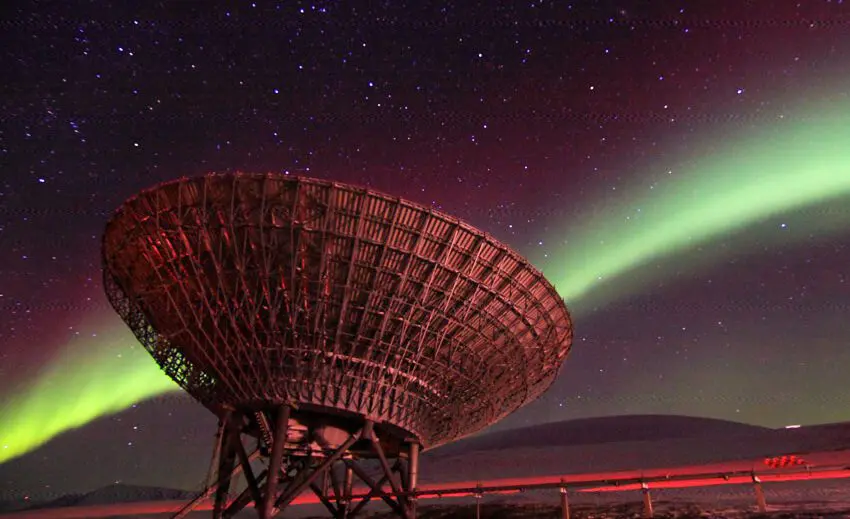AGF-304 Radar Diagnostics of Space Plasma (15 ECTS)
ID:
AGF-304
CREDITS:
15 ECTS
COURSE PERIOD:
Spring semester - cancelled in 2025

Northern lights (Aurora Borealis) over the EISCAT Svalbard Radar. Photo: Njål Gulbrandsen/UNIS.
Note: This course will not be offered in 2025
| Grade: | Letter grade (A through F) |
| Course Cost: | None |
| Course Capacity Min/Max: | 8/16 students (AGF-304/804 in total) |
| Language of instruction: | English |
| Examination support material: | Bilingual dictionary between English and mother tongue |
Course requirements
Enrolment in a relevant master programme in geophysics. General knowledge of basic atmospheric physics and/or electrodynamics. Priority will be given to students with knowledge of ionospheric/space physics or are enrolled on a study program focused towards ionospheric and/or space physics.
The course should be combined with AGF-301 The Upper Polar Atmosphere. The two courses are designed to complement each other.
Academic content
The course will begin with a brief introduction to the ionosphere and a discussion of basic ionospheric HF sounding techniques and radar design. Students will be given an introduction to basic plasma physics discussing both the fluid and kinetic theory approaches before providing a detailed description of how these fundamental theories are applied to the incoherent scattering processes. Lectures will also focus on the mathematical techniques utilized in the signal analysis process (including the statistical assumptions and techniques used). Significant time will also be spent discussing the resulting autocorrelation function and power density spectrum and how this relates to the intrinsic properties of the plasma.
A technical description will be given of various types of incoherent scatter radars including transmitter, receivers and antenna design. Students will be taught about different radar measurement techniques including simple and coded pulse methodology, pulse decoding processes and lag profile matrixes.
A series of interactive seminars and lectures will be used to familiarise students to the scientific interpretation of incoherent radar data and how to combine it with other datasets such as optical and satellite data. Students will be introduced to the EISCAT Svalbard Radar (ESR) experimental modes and taught how to run the ESR. Working in small groups, they must design their own radar experiment (the data from which will form the basis of part of their project report) which they will be responsible for running during the field work. In addition, they will be given hands on experience of building a simple radar system and utilizing simple programs to investigate the basics of signal processing.
Students will be taught how to use the MATLAB data analysis program GUISDAP (Grand Unified Incoherent Scatter Design and Analysis Package), which is used to process the EISCAT radar measurements. Knowledge of a programming language (e.g. Matlab or Python) is advantageous but not essential for the course as students will be given some basic programming exercises to complete at the start of the course.
Learning outcomes
Upon completing the course, the students will:
Knowledge
- have detailed knowledge of radar techniques employed in the field of space plasma and ionospheric physics research, including radar design, incoherent scatter plasma theory, pulse coding techniques, and signal processing
- understand the methodology by which ionospheric plasma parameters can be derived from an auto-correlation function
- understand mathematical descriptions of plasma density fluctuations and statistical methods utilized in signal analysis.
- be able to interpret and discuss incoherent scatter radar data in the context of ionospheric and magnetospheric processes.
Skills
- operate an incoherent scatter radar as part of a group
- utilise the radar data analysis package (GUISDAP) in analysing multiple data sets
- analyse data and recognise the different analysis techniques used
- describe orally the underlying physical principles surrounding incoherent scatter theory, pulse coding and signal analysis techniques
- identify signatures of different ionospheric processes in incoherent scatter radar data
General competences
- discuss a scientific case study utilizing multiple data with their peers
- produce a short written report detailing radar analysis techniques and data interpretation
- participate in a group presentation of a scientific paper from a peer reviewed journal.
Learning activities
The course extends over a full semester and is run in combination with AGF-804. Initially, students attend one week of compulsory Arctic survival and safety training (AS-101).
The main learning activities of the course are:
- lectures detailing the fundamental physical and mathematical techniques utilized in incoherent scatter radar theory including pulse coding and signal processing
- interactive seminars focusing on data interpretation
- data analysis techniques utilizing MATLAB and the GUISDAP analysis program
- five days field work at the EISCAT Svalbard Radar where students will be expected to operate the radar using the radar control software
- produce a written report based upon analysis techniques and data interpretation.
Summary
- Total lecture hours: 60 hours.
- Total seminar and exercises hours: 16 hours.
- Total computer lab hours: 16 hours.
- Fieldwork at EISCAT Svalbard Radar: 5 days
Compulsory learning activities
All compulsory learning activities must be approved in order to sit the exam.
- Fieldwork
- Written report
Assessment
| Method |
Percentage of final grade
|
| Oral exam | 100 % |
Student life

